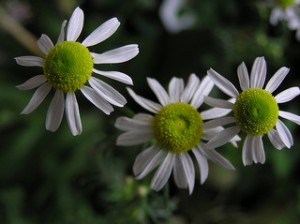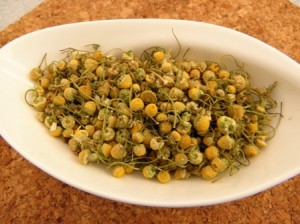
Chamomile tea is well known as a herbal tea that is very beneficial to drink prior to heading off to bed at night — as an aid to gaining a restful night’s sleep. Aside from that one property, there are actually quite a few other benefits gained from regularly drinking Chamomile tea, some of which are less well known than others.
Chamomile Flower

While there are two main types of Chamomile plant, the main type used to make Chamomile tea is the German Chamomile. German Chamomile is an annual plant which needs to be re-planted each year. The other kind, Roman Chamomile, is a perennial plant and while it is sometimes used for tea it is also often used to make other herbal aids. Fortunately, for those who enjoy growing their own herbs and plants, both types of chamomile are easy to grow though the fact that Roman Chamomile is a perennial plant often makes it the one chosen. Both plants have beneficial properties though I have heard that many herbalists feel the German variety is more potent. Our Chamomile tea is made from the German Chamomile plant.
Harvesting and Drying the Flowers
Tea is made from the whole Chamomile flowers, which are clipped off the plant once they are in full bloom. Do not use the stems or leaves from the plant–just the flowers. The flowers are actually quite easy to use your fingers as a “rake”, pulling them through the plant to harvest the flowers. While you can use the flowers as soon as they are harvested, most people opt to dry the flowers so they can be used all year round. Most of the teas you buy are made using dried Chamomile flowers.
Air drying the flowers works quite well. Simply lay them outside on clean screens till they are dried–no need to wash the flowers first as it’s unlikely that there would be any dirt on th em. Of course, watch out for any summer rain storms! Once they are dry, store them in an air tight container, small Mason jars work well. Most recommend storing herbs for a year only.
Making Chamomile Tea
 Chamomile tea is relatively easy to make. If using fresh flowers the ratio is one cup of flowers to a pint of water. Most people find using dried chamomile is more convenient. For dried chamomile, two tablespoons per cup of water is usually all that’s needed. If you find the tea is too strong or too weak, you can vary the ratio of chamomile to water till you find the right one.
Chamomile tea is relatively easy to make. If using fresh flowers the ratio is one cup of flowers to a pint of water. Most people find using dried chamomile is more convenient. For dried chamomile, two tablespoons per cup of water is usually all that’s needed. If you find the tea is too strong or too weak, you can vary the ratio of chamomile to water till you find the right one.
I like to brew my herb teas using a tea infuser. Usually I’ll pop the leaves into the infuser unit of a teapot, pour on boiling water and let it sit for a while. You can also use the small ball infusers that you dunk into a cup of freshly boiled water although you would have to use a fairly large infuser in order to use the right amount of chamomile.
Chamomile Tea Benefits
As with many herbal teas and infusions, there are limits on how much you should drink each day in order to reap optimum benefits. Normally, adults should not drink more than two or three cups each day. You can get plenty of benefit from just drinking one cup before bed. Young children do not drink this tea — unless you are giving a little to calm an upset tummy. Normally, I recommend one cup a day.
Sedative Properties: This is perhaps the best known property of chamomile tea, and the reason many people drink it before bed. Studies have shown that Chamomile does have sedative properties and it is also a great help in soothing nerves.
Settling Upset Stomachs: You will often find chamomile one of the ingredients used, along with peppermint, to help calm an upset tummy. It has a soothing effect on the stomach muscles and lining, and is particularly useful for those suffering from any type of irritable bowel syndrome. A word of caution, it should not be used for morning sickness as chamomile is not recommended to drink while pregnant.
Antibacterial Properties: Some of the lesser known properties are its antibacterial and anti-fungal properties. Gargling with chamomile tea is great if you have a sore throat or use it as a mouth wash if you have mouth sores. Externally, a poultice can be made from chamomile flowers and placed on skin infections — though the mix of flowers to water would need to be about three times stronger if you are using it externally.
Side Effects-Chamomile Tea and Pregnancy, Other Precautions
Unlike green, oolong and black teas, there is a limit to how much you should drink each day. One cup per day (or night, before bed) will often prove beneficial — certainly no more than three cups a day should be consumed.
There are a few known side-effects. First of all, do not drink the tea if you are allergic to flowers such as daisies, ragweed, asters, chrysanthemums or marigolds you as it could cause an allergic reaction. It can interact with certain medicines, including blood thinning medication, so it should not be used if you are taking any kind of blood thinning medicine (including aspirin), nor should pregnant women or those with blood related disorders drink it. If you are using birth control pills you may want to check with your doctor to ensure it is safe to drink chamomile tea.
The Best Type of Chamomile Tea to Buy
It is relatively easy to find chamomile tea and other chamomile products online and in health stores. You can even find chamomile teabags in supermarkets. To gain the best results from this tea, I’d suggest purchasing the actual dried chamomile flowers. The powdered form of chamomile tea and chamomile tea bags do not have the same benefits as those derived from making tea using the whole flowers.
We have a selection of chamomile tea available for purchasing here.